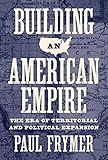Building an American Empire : The Era of Territorial and Political Expansion / Paul Frymer.
Material type: TextSeries: Princeton Studies in American Politics: Historical, International, and Comparative Perspectives ; 156Publisher: Princeton, NJ : Princeton University Press, [2017]Copyright date: ©2017Description: 1 online resource (312 p.) : 3 halftones. 5 line illus. 19 mapsContent type:
TextSeries: Princeton Studies in American Politics: Historical, International, and Comparative Perspectives ; 156Publisher: Princeton, NJ : Princeton University Press, [2017]Copyright date: ©2017Description: 1 online resource (312 p.) : 3 halftones. 5 line illus. 19 mapsContent type: - 9780691166056
- 9781400885350
- Frontier and pioneer life -- United States -- Historiography
- Frontier and pioneer life
- Frontier thesis
- Imperialism -- Case studies
- Imperialism -- 19th century -- Case studies
- Land settlement -- United States -- Historiography
- Land settlement
- National characteristics, American -- Historiography
- POLITICAL SCIENCE / Political Ideologies / Nationalism & Patriotism
- Abraham Lincoln
- African slavery
- American empire
- American expansion
- American frontier
- Cuba
- Dominican Republic
- Emancipation Proclamation
- Frederick Jackson Turner
- French settlers
- Hawai'i
- Homestead Act
- Indian Removal Act
- Latin America
- Louisiana Purchase
- Louisiana
- Mexico
- Mississippi River
- Mississippi
- Native Americans
- New Mexico
- Oklahoma
- Orleans Territory
- Theodore Roosevelt
- United States
- Woodrow Wilson
- black colonization
- boundary lines
- empire
- federal land policies
- foreign policy
- free blacks
- homesteading
- judges
- land incorporation
- land policies
- land
- manifest destiny
- political development
- population control
- population movements
- preemption
- public domain
- race
- settlement policies
- settlement
- settler rights
- slavery
- sovereignty
- state formation
- territorial expansion
- the frontier
- westward expansion
- white settler nation
- whiteness
- online - DeGruyter
- Issued also in print.
| Item type | Current library | Call number | URL | Status | Notes | Barcode | |
|---|---|---|---|---|---|---|---|
 eBook
eBook
|
Biblioteca "Angelicum" Pont. Univ. S.Tommaso d'Aquino Nuvola online | online - DeGruyter (Browse shelf(Opens below)) | Online access | Not for loan (Accesso limitato) | Accesso per gli utenti autorizzati / Access for authorized users | (dgr)9781400885350 |
Frontmatter -- Contents -- Figures -- Acknowledgments -- Chapter 1. Introduction -- Chapter 2. Boundaries and Movement -- Chapter 3. "Advancing Compactly as We Multiply" -- Chapter 4. Homesteading and Manufacturing Whiteness -- Chapter 5. The Limits of Manifest Destiny -- Chapter 6. A Second Removal? -- Chapter 7. America's Settler Empire at the End of the Frontier -- Index
restricted access online access with authorization star
http://purl.org/coar/access_right/c_16ec
How American westward expansion was governmentally engineered to promote the formation of a white settler nationWestward expansion of the United States is most conventionally remembered for rugged individualism, geographic isolationism, and a fair amount of luck. Yet the establishment of the forty-eight contiguous states was hardly a foregone conclusion, and the federal government played a critical role in its success. This book examines the politics of American expansion, showing how the government's regulation of population movements on the frontier, both settlement and removal, advanced national aspirations for empire and promoted the formation of a white settler nation.Building an American Empire details how a government that struggled to exercise plenary power used federal land policy to assert authority over the direction of expansion by engineering the pace and patterns of settlement and to control the movement of populations. At times, the government mobilized populations for compact settlement in strategically important areas of the frontier; at other times, policies were designed to actively restrain settler populations in order to prevent violence, international conflict, and breakaway states. Paul Frymer examines how these settlement patterns helped construct a dominant racial vision for America by incentivizing and directing the movement of white European settlers onto indigenous and diversely populated lands. These efforts were hardly seamless, and Frymer pays close attention to the failures as well, from the lack of further expansion into Latin America to the defeat of the black colonization movement.Building an American Empire reveals the lasting and profound significance government settlement policies had for the nation, both for establishing America as dominantly white and for restricting broader aspirations for empire in lands that could not be so racially engineered.
Issued also in print.
Mode of access: Internet via World Wide Web.
In English.
Description based on online resource; title from PDF title page (publisher's Web site, viewed 29. Jul 2021)


